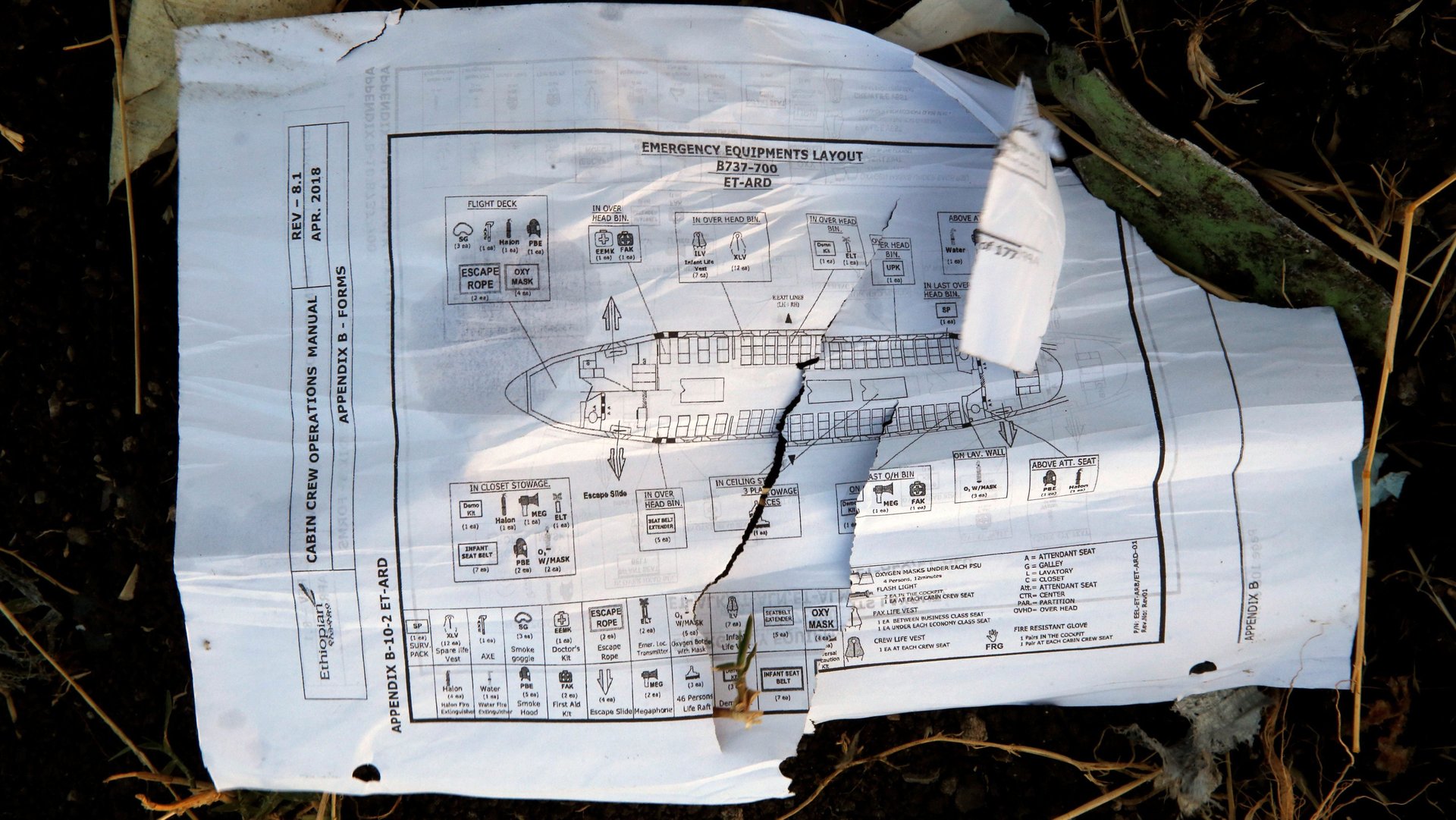Following steps recommended by Boeing didn’t save the Ethiopian flight
Black box data from the Ethiopian Airlines flight that crashed March 10 show the pilots began carrying out the proper steps to override a flight system implicated in an earlier crash of the aircraft, according to the Wall Street Journal (paywall).


Black box data from the Ethiopian Airlines flight that crashed March 10 show the pilots began carrying out the proper steps to override a flight system implicated in an earlier crash of the aircraft, according to the Wall Street Journal (paywall).
The flight system, which kicks in when the plane senses an impending stall, began pointing the plane’s nose downward (paywall) when the jet was just 450 feet (137 meters) above ground. Overriding the system involves flipping two switches to cut power to the system and then stabilizing the plane manually by rotating a control wheel. Boeing directed airlines to these steps after the first crash of a Lion Air 737 Max in Indonesia which killed all 189 on board, after pilots battled the anti-stall system.
Black-box data showed the pilots did this, people familiar with the accident investigation findings, which are not yet public, told the Journal. Following the recommended process also means that autopilot can’t be used for the remainder of the flight, according to pilots familiar with the 737 Max system.
However, after turning off power to the flight system, the pilots couldn’t get the plane to climb. They then flipped the switches again to restore power to electrical controls. Just six minutes after taking off, the plane crashed in a field, killing all 157 people on board.
If the preliminary report on the Ethiopian Airlines crash, which could be published as soon as this week, shows the pilots did what they were supposed to in order to avert disaster and yet were unable to save the plane, the consequences would be grave for Boeing. For one, such findings would strengthen doubts around the plane’s airworthiness, and its future.
Boeing has said the 737 Max is safe to fly, despite a growing number of questions about its design and certification by the US Federal Aviation Administration (FAA). The plane has bigger engines than earlier 737 variations it is based on, and they are placed further forward, altering the plane’s center of gravity and leading it to pitch up. For that reason, Boeing added what many are calling a “kludge,” a way to counteract the aerodynamic tendencies of the plane without pilot intervention. It’s called the Maneuvering Characteristics Augmentation System, or MCAS, and points the plane’s nose sharply down in response to sensor data that warns of an impending stall.
Pilots were not informed of the presence of that system or trained on it until after the first crash. In the wake of that tragedy, airlines imparted training on MCAS, and on how to override it to pilots. Many pilots have said they believe that with the proper training the plane is perfectly safe to fly. But some of them have also noted that multiple steps are required to happen at the same time, leaving little margin for error at a crucial time, given the anti-stall system can kick in at relatively low altitudes. Airlines in the US have said tracking thousands of hours of Max flights has not shown indication for concern.
Boeing has said it is continuing to work with the FAA and other regulatory agencies worldwide on the development and certification of an MCAS software update that will make the system less powerful, as well as a training program. “Safety is our first priority, and we will take a thorough and methodical approach to the development and testing of the update to ensure we take the time to get it right,” it said yesterday (April 2).
Ethiopian Airlines is among the few carriers to have a ready-to-use 737 Max simulator (paywall), although it notes that the simulator is not designed to mimic the Lion Air problem. It also says its pilots flying the Max were trained on the processes the FAA and Boeing directed pilots to follow to deal with the MCAS, a marked difference from the circumstances surrounding the Lion Air flight.
In the wake of the Indonesia crash, Boeing had highlighted the fact that pilots flying the same plane a day earlier were able to resolve the problem and continue their flight safely. Cockpit voice data leaked to Reuters showed the pilots on the Lion Air flight did not follow the steps used on the plane’s penultimate flight, and were looking through a reference guide for procedures to follow.
If the black-box findings from Ethiopia are able to show that pilot error was not a major factor in the crash, that would strengthen the cases being brought to lawyers on behalf of crash victims that the plane is not safe as designed. A legal case focused on the design of the plane, which occurred in the US, rather than operational or training issues would have a stronger chance of being heard in a US court than would normally be the case for crashes that occurred overseas—and therefore a much stronger chance of winning hefty compensation from Boeing.